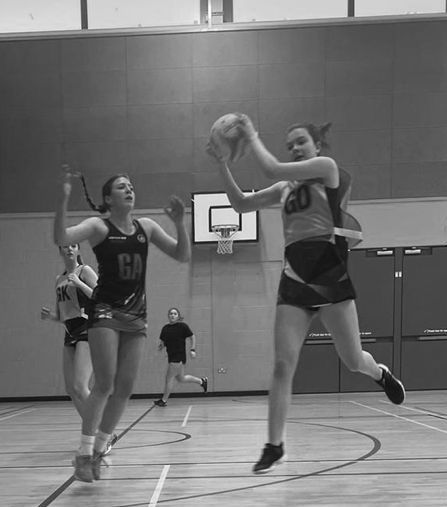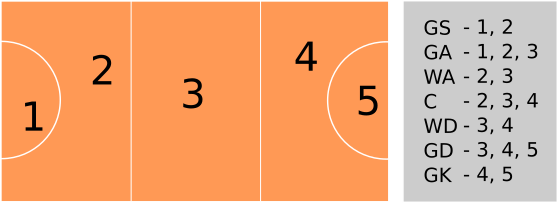Starting a Netball Club:
Rules and Training Plans

Introduction to Netball
What is Netball
Netball is a fast-paced, dynamic team sport that is open to all genders. It is played on a rectangular court with goal posts at each end. A netball team consists of seven players. The objective is to score points by working together to pass and catch the ball, ultimately shooting it through the opponent's hoop. Netball is both exciting and challenging, offering players the chance to develop a range of skills.
Netball is particularly popular at the school level due to its fun, team-oriented nature and the numerous health benefits it offers. It also provides a fantastic opportunity for young players to make new friends and build lasting connections.
Starting a netball club brings many benefits for young players, including improvements in both mental and physical health. Additionally, netball fosters social development and is an inclusive sport that welcomes participants of all abilities.
Who is this Guide for?
This page is designed for anyone interested in introducing netball to their community, school, or club. It’s an excellent resource for primary school teachers looking to establish a fun and engaging netball program for students, as well as for sports clubs that want to expand their offerings by adding netball to their lineup of activities. Community groups or small communities looking to start an amateur netball club will also find valuable guidance on organizing, training, and introducing the sport to new players of all ages. Whether you’re a teacher, coach, parent, or community organizer, this page provides the basic rules, training plans, and resources needed to help young players get started with netball.
Basic Netball Rules
Quick Overview of Key Netball Rules
In netball, each team consists of seven players, each assigned a specific position that defines their role and movement on the court. The positions are Goal Shooter (GS), Goal Attack (GA), Wing Attack (WA), Centre (C), Wing Defense (WD), Goal Defense (GD), and Goal Keeper (GK). Each position has designated areas where players are allowed to move:

Goal Shooter (GS) and Goal Attack (GA) are the only players who can score. They play in the attacking third, with GA also allowed in the center third.
Wing Attack (WA) focuses on feeding the ball into the shooting circle and can move within the attacking and center thirds, but not in the shooting circle.
Centre (C) is the most versatile position, allowed to move across all three thirds except the shooting circles, making them pivotal in transitions.
Wing Defense (WD) helps prevent the ball from entering the attacking third and can move within the defensive and center thirds.
Goal Defense (GD) and Goal Keeper (GK) protect the goal. GK remains within the defensive third, while GD can also move into the center third to support defense. Each player's movement restrictions are essential for maintaining the structure and flow of the game.
In netball, footwork rules are essential for maintaining fair play and flow in the game. Dribbling or running with the ball is not allowed, and players must pass or shoot without taking steps. When a player catches the ball and lands on both feet simultaneously, they must choose one foot to remain grounded on the landing spot, while the other foot can pivot or move. If a player lands on one foot, that foot must stay in place, serving as the pivot foot, while the other can be used for balance or turning. Players are prohibited from holding the ball without attempting to pass or shoot, for longer than 3 seconds. Players cannot catch a ball they have just thrown, the ball must touch the hoop or another player before they can catch it again.
These footwork rules emphasize precision and control, encouraging players to develop quick decision-making and accurate passing skills.
Netball’s non-contact rule is designed to ensure player safety and fair play, prohibiting physical interference that could disrupt the opponent’s movement or control of the ball. Prohibited actions include grabbing or pushing with hands or elbows, snatching the ball directly from another player’s hands, and blocking opponents by spreading arms or obstructing them with an extended stance. Players cannot make direct physical contact to prevent an opponent from moving or passing. However, players are allowed to compete for position by using their bodies strategically. They can hold their ground, use their bodies to shield the ball, and maintain or fight for position by leaning in or pushing back against opponents. This balance allows players to engage competitively while respecting the non-contact principle, focusing on skillful positioning rather than aggressive physical play.
What do you need to start?
Starting netball sessions requires minimal equipment and a well-structured approach to coaching. The essential items include a
netball,
a court or open space with clear markings, and at least
one netball post per goal end. Players should wear
comfortable sportswear and appropriate footwear for quick movements and stability. To help organize drills and gameplay,
cones can be used for marking positions, and
bibs are useful for distinguishing teams during practice matches.
Beyond equipment, a successful session needs a basic understanding of netball rules, a structured training plan, and enthusiastic participants. Coaches or organizers should focus on teaching fundamental skills such as passing, shooting, footwork, and movement. Encouraging teamwork and making sessions engaging will help players develop confidence and improve their skills. Whether coaching in a school, a community club, or an amateur team, a positive and inclusive environment is key to making netball an enjoyable experience for all players.
Training
Basic level
The primary goal of basic netball training is to develop fundamental skills that allow players to confidently participate in the game. At this level, the focus is on catching and passing, ensuring players can securely receive and accurately deliver the ball using chest, bounce, and overhead passes. Footwork and movement basics are also essential, teaching players how to pivot, change direction quickly, and position themselves effectively on the court.
Another key objective is spatial awareness and teamwork, helping players understand their positions, move into open space, and communicate with teammates. Players will also practice shooting techniques, learning proper form and positioning to score goals efficiently. Defensive fundamentals, such as marking opponents and intercepting passes, will be introduced to develop well-rounded skills.
By focusing on these foundational elements, beginner players will build confidence, improve coordination, and gain a solid understanding of netball’s basic principles, setting the stage for more advanced gameplay.
Ready position
The Ready Position Exercise is essential for netball players to develop agility, balance, and responsiveness on the court. This exercise focuses on teaching players the optimal stance to quickly react to passes, intercepts, and movements. In the ready position, players stand with their feet shoulder-width apart, knees slightly bent, and weight balanced on the balls of their feet. Hands are held in front, ready to receive or intercept the ball. This stance prepares players for fast direction changes, allowing them to stay low and stable while remaining alert. Repeating this exercise helps players build muscle memory, enhancing their overall defensive and offensive capabilities during a game.
Ready position - lean forward - jog
To develop quick acceleration, players start in the ready position and, on a signal (such as a whistle or clap), lean slightly forward before transitioning into a light jog. The focus here is not on sprinting but on getting comfortable with shifting weight forward and moving quickly while maintaining balance and control. This drill helps players develop awareness of their stance and how to transition smoothly into movement.
Ready position - lean forward - sprint
The goal is to develop quick reaction times and powerful take-offs, which are crucial for chasing loose balls, intercepting passes, and repositioning swiftly during gameplay. Emphasis should be placed on maintaining balance, staying low, and driving forward with strong leg movement. This drill helps players build speed while reinforcing the importance of a stable and reactive stance.
Straight drive towards ball
This advanced drill combines acceleration from the ready position with catching skills to simulate game-like scenarios. Players form a line, with one person standing ahead holding the ball. The first player in line assumes the ready position (feet shoulder-width apart, knees bent, weight on the balls of their feet). On a signal, the player in the ready position sprints toward the person with the ball. After a few strides, the person holding the ball delivers a chest pass or bounce pass to the sprinting player.
The receiving player must focus on maintaining control and balance while sprinting and catching the ball on the move. Once the catch is completed, the player joins the back of the line, and the next player in line repeats the drill.
This exercise helps improve timing, hand-eye coordination, and the ability to make clean catches while in motion. It also reinforces quick decision-making, which is crucial during high-pressure gameplay situations.
45 degree drive towards ball
This drill focuses on directional movement, acceleration, and catching under pressure, simulating real game scenarios where players need to change angles quickly. Players form a line, with one person standing ahead holding the ball. The first player in line begins in the ready position (feet shoulder-width apart, knees bent, and weight on the balls of their feet).
On a signal, the player explodes into a sprint at a 45-degree angle to the left. After a few strides, the person holding the ball delivers a chest pass or bounce pass to the sprinting player. Once the ball is caught, the player jogs back to the line. The next repetition involves sprinting at a 45-degree angle to the right, alternating sides for each player.
This drill develops quick directional changes, footwork precision, and the ability to catch a pass while moving at an angle. It also reinforces awareness of positioning and balance, which are essential for game play when attacking or intercepting.



